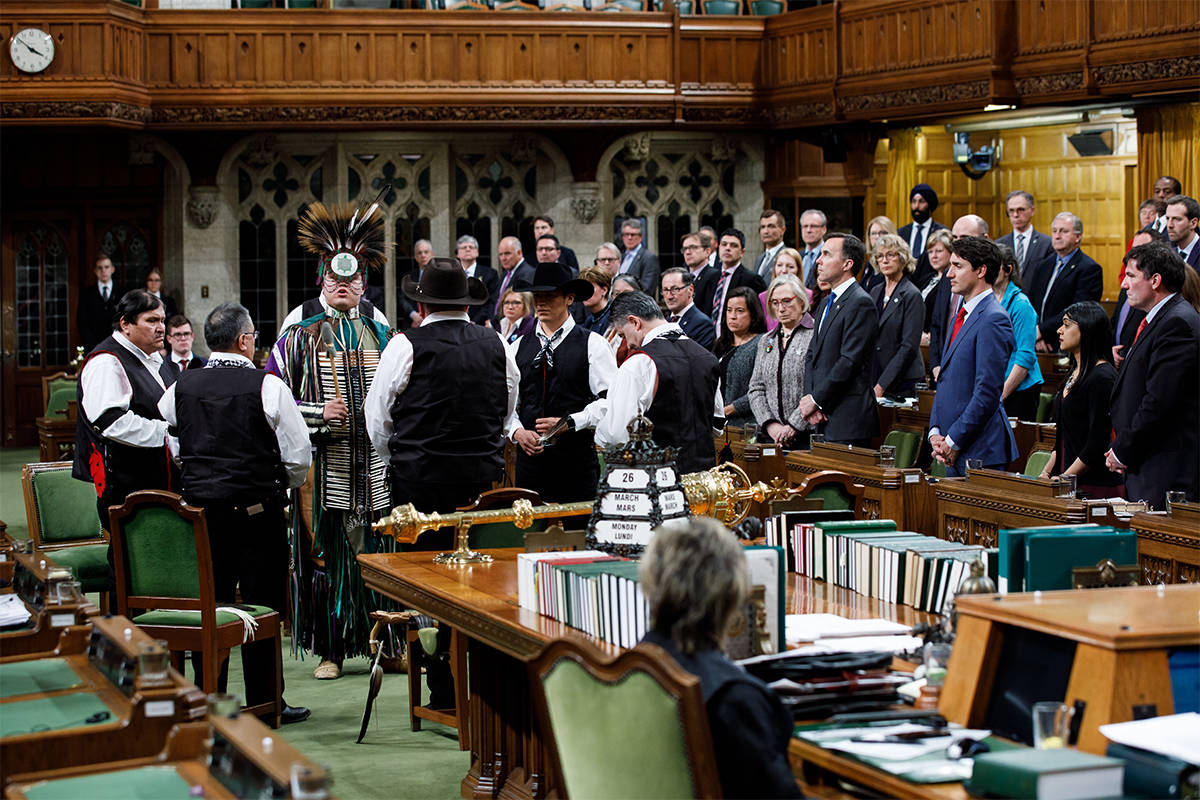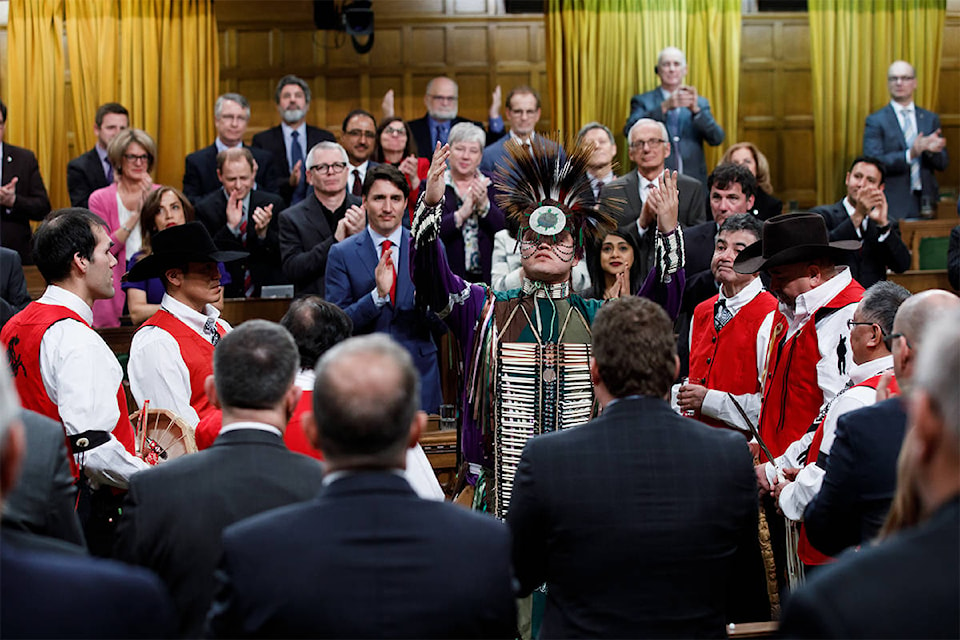Dressed in full regalia, Peyal Laceese, youth ambassador for the Tsilqhot’in National Government, led a drum ceremony from the floor of the House of Commons, March 26.
In a historic moment, following Prime Minister Justin Trudeau’s exoneration of six Tsilhqot’in war chiefs hanged in 1864 and 65, Laceese, 20, performed a song that had only come to him the night before, in a dream.
The names of the six chiefs were incorporated into the words of the song:
“As I was singing the song I envisioned who the warriors were while I said the names,” said Laceese.
Laceese, himself, is named after one of the war chiefs, Chief Biyal (pe-yal). As he sang, the images of the six came to his head: Lhats’as?in (Lhas-awss-een) head war chief, Chief Tahpitt (ta-peet), Chief Tellot (tay-lot), Chief Chayses (chay-sus), Chief Biyil (pe-yal), and Chief Ahan.
“I saved Chief Ahan for last. People explained him as one of the fiercest chiefs. When we say in our language Ahan, what originates when you say that word it means to wipe out, to exterminate,” said Laceese. “That is our word for that foe, when something takes out a lot of people in a mass destruction, that’s what kind of person Ahan was for us. I saved that word for last because it carried that power as well. I could feel his spirit with his hands clenched.”
Read more: Prime Minister Justin Trudeau formally exonerates Tsilhqot’in war chiefs
As he was singing, Laceese said he felt like the song lifted the house, and that he could feel others singing with him.
“I didn’t see anyone, it must be them singing with me, I felt like they were happy to sing the song,” he said.
“It was good that sense of feeling of fists being clenched in that room, and then after that song was done, it was a release of those fists, open hands releasing to shake hands,” he said. “After that it was a like a weight off of the shoulders, like holding onto a rope that is burning your hands and to be able to let go and go forward from that point.”
Following the song, Laceese gifted his drum to the prime minister, and gave him a hug before exiting the floor.
“It was quite the experience to be able to not only sing that song for the first time, to be that drum’s first song to be sung upon and to gift it, that drum quitting on a high note. It has that special power with it and it will carry that song with that drum and [the prime minister] told me when I gave it to him he will probably hang it in his office.”
It was only an hour before the Tsilhqot’in chiefs were due on the floor of the House of Commons that Laceese found out he would be allowed to drum and sing on the floor of the house.
The request from Tsilhqot’in leaders had to be approved by the house, and was unprecedented in parliament’s history.
“To me it was us going in there and leaving footprints,” said Laceese. “Being Tsilhqot’in, we leave really big footprints.”
Laceese hopes the exoneration and drum ceremony will provide a path for Indigenous peoples across Canada and the world to follow.
“In leaving those footprints, they will remain in the House of Commons, so not only us will find those footprints to follow, it will be other First Nation across Canada and across the world to see those footprints and follow and that is what we aim for, not only for us as Tsilhqot’in, but our ancestors who tried to make those footprints before, and those nations across Canada who are following those footprints.”
Read more: Tsilhqot’in 1864 war chiefs exoneration celebrated in region’s various communities
It’s not uncommon for Tsilhqot’in teachings and stories and songs to come from dreams, or the spirit world, said Laceese.
“I had a vision that the six chiefs that were hung, were there in spirit and I heard a song outside and that was the song,” he said.
“I heard the song, it was the air and the wind that song. It sounded like a really big person was singing it, a deep voice, so that’s why I tried to do it in that style, in the House of Commons.”
When Laceese, woke up he said he had to keep singing the song in his head so as to remember it when he got to the house. He said Elders he has spoken to about the chant say it is done in a traditional Tsilqhot’in style they remember from their youth.
“It shook the earth. The song had power and that’s the way I wanted to keep it, so I tried my best to sing it that way.”
The young man looks forward to teaching the song to others and is eager to continue along the path opened through the exoneration and the drum ceremony for nation to nation relations.
“I can’t explain in any language how honoured I am to have this experience on my hands and to be able to hold these stories and be the one to tell them personally, that I was there and I am happy to look forward for the youth to come so we can work on learning more songs and so I can pass on these songs and the language and the stories.”
Read more: Premier Christy Clark apologizes for 1864 Tsilhqot’in hangings
@Tspricker
tara.sprickerhoff@wltribune.com
Like us on Facebook and follow us on Twitter.

